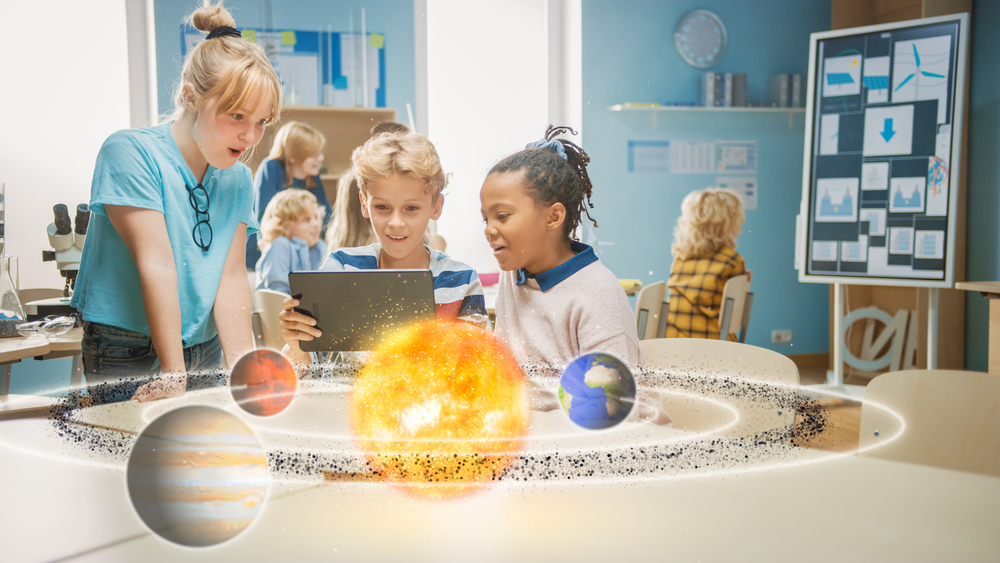Dubai is fast becoming a technology and innovation hub of the world. Among the numerous developments that are redefining its future, the adoption of 360 virtual reality in education is noteworthy. This virtual technology has left the domain of fantasies about a future world behind; it is increasingly becoming a part of Dubai’s education system.
The use of virtual reality in education in the city is not only making learning more effective but also revolutionizing the mode of knowledge transmission itself.
What Does 360 Virtual Reality Really Mean?
This entails absolute immersion, where students can move around and actively engage in worlds carried from an artificial world directly to space in three dimensions in the most basic way. Unlike other forms of media, this technology surrounds learners in sights and sounds from all directions possible, making abstract or complicated matters more concrete.
Dubai is a city that is ready to adopt new technology, making this technology a game-changer in the city.
How Dubai Schools Are Embracing Virtual Reality?
The advent of VR in Dubai schools represents a broader commitment to educational innovation. From the government to private organizations, there have been massive investments into virtual reality hardware.
Classes fitted with VR headsets give students virtual tours of ancient monuments, outer space, or science experiments without budging from their desks. Especially to young students, this interactive environment has much appeal due to the touch-and-feel concept of experiential learning.
Second, VR is filling the gaps in conventional learning. For example, disciplines like geography or biology are not static anymore. A learner studying the heart can dissect it virtually and study its structures and functions, which cannot be achieved through books.
Effect on Learning Outcomes
Studies done in Dubai have concluded that virtual reality in education increases retention rates and creates interest. Whenever students learn something at a 360-degree level, they learn better and understand more.
This method is also in line with Dubai’s vision to develop critical thinking and problem-solving skills from an early age.The multisensory nature of 360 virtual reality is appealing to more than one type of learner.
Visual learners, kinesthetic learners, and even those who struggle with the old way of reading enjoy the immersive, interactive environment of VR. Teachers have noted increased enthusiasm and participation, and obviously, it is more than a novelty; it is becoming a must-have in the classroom.
Increasing Inclusivity and Accessibility
One of the less-seen benefits of VR in Dubai schools is its incredible capacity to promote inclusivity. Disabled students, or those who have difficulty moving around, are now given unprecedented exposure to activities previously out of their reach.
For instance, students in wheelchairs can now go on virtual field trips, thereby promoting a more inclusive learning environment.This individualized method is essential to Dubai’s multiethnic student base.
Challenges and the Way Forward
Although it is beneficial, virtual reality in education is not without its drawbacks. The price of high-end VR equipment and content development is still expensive, although costs are gradually coming down. The second hurdle is educating teachers on how to properly use VR in their teaching so that technology enhances instruction and doesn’t overwhelm it.
Dubai’s education authorities are tackling these challenges with collaboration with technology firms and pilot programs in schools. The plan is to create a sustainable model in which 360 virtual reality is integrated into normal learning, not merely as an occasional addition.
Why VR Matters for Dubai’s Future
The pursuit of 360 virtual reality in the educational sector of Dubai is completely aligned with the city’s vision of building its future citizens. Through the incorporation of immersive technologies in learning from a young age, Dubai equips its students to face the digital fluency and adaptability necessary to excel.
Such skills are now a necessity in a world where virtual interfaces and artificial intelligence are poised to dominate most sectors. Such a policy change also completely fits Dubai’s vision of becoming a smart city in which living standards are upgraded and economic growth is triggered by technology. As more is known about virtual reality worlds, students will be more driven towards technology-based fields like healthcare, engineering, and creative arts.
Conclusion
The integration of 360 virtual reality in the educational system of Dubai is not just a technological revolution; it is a revolution. Even though interactive experiences enhance the curriculum, how students learn, understand, and interact is undergoing a transformation process.
VR in Dubai schools is leading the way, setting an example for effective technology and learning implementation. For educators and schools ready to adopt or increase virtual reality in education, professional expertise is crucial.
Dubai’s Limina Studios is a pioneer in providing end-to-end 360 virtual reality solutions with a focus on special educational applications. From virtual tours that immerse students to developing interactive VR content, Limina Studios equips schools to leverage the potential of this revolutionary technology maximally. As the Dubai education sector continues to open the door to innovation, 360 virtual reality will be at the forefront, determining the shape of the future of knowledge sharing and knowledge absorption.






















